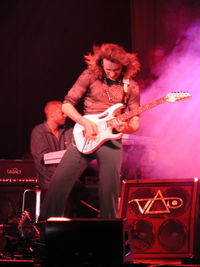
Steve Vai Biography
Along with his one-time teacher Joe Satriani, seven-string wizard Steve Vai set the standard for rock guitar virtuosity in the '80s. Born on June 6, 1960, and raised in Carle Place, NY, Vai became interested in the guitar via such legendary artists as Jimi Hendrix, Led Zeppelin, and Alice Cooper as a teenager, and upon starting high school, took lessons with an older player from his high school, Joe Satriani. Playing in several local bands, Vai quickly picked up on the instrument, and by the age of 18 was attending the renowned Berklee School of Music in Boston. As a student there, Vai transcribed several of Frank Zappa's most technically demanding compositions for guitar, and even sent a copy of one such transcription, "Black Page," to Zappa himself. Zappa was so impressed with the young guitarist that upon meeting him, he invited Vai to join his band.
Subsequently, Vai toured the world with Zappa (giving Vai the nicknames "Stunt Guitarist" and "Little Italian Virtuoso"), and played on such albums as 1981's Tinsel Town Rebellion and You Are What You Is, 1982's Ship Arriving Too Late, 1983's Man From Utopia, plus 1984's Them or Us and Thing Fish, before leaving to set out on his own. First off was a pair of self-financed, recorded, and released solo albums in 1984, Flex-Able and Flex-Able Leftovers, both of which showcased Vai's guitar playing and songwriting talents, yet were still heavily influenced byZappa.
With Van Halen all the rage by the mid-'80s due to their massive hard rock/pop crossover success, Vai replaced Yngwie Malmsteen in a similarly styled outfit called Alcatrazz (which featured former Rainbow vocalist Graham Bonnett), playing on their overlooked 1985 release, Disturbing the Peace. The same year, Vai made a cameo appearance in the movie Crossroads (playing the devil's guitarist and shredding away in a guitar duel with Ralph Macchio) and got an invite from his friend/bass master Billy Sheehan to try out for the guitar spot in singer David Lee Roth's solo band (Roth had just split from Van Halen), and eventually landed the gig. 1986 saw the debut release from Roth and his stellar solo band, Eat 'Em Smile, which went on to become one of the year's top hard rock releases. Both Vai and Sheehan were catapulted to super-stardom due to their instrumental talents, as they took top honors in numerous guitar magazines for years afterwards.
But although the quartet showed great promise, Sheehan jumped ship just after their sophomore album, Skyscraper, was issued in 1988. Although the album was more pop-based than its predecessor, it became another sizeable hit -- with Vai earning a co-producing credit on the album along with Roth. The same year, Vai issued his own line of snazzy guitars, the Jem 777 series, via the Ibanez company. After the ensuing tour with Roth wrapped up in late '88, it was Vai's turn to jump ship. In addition to working on another solo album, he was invited to join up with chart topping pop-metallists Whitesnake, an offer which he accepted. His one and only album with Whitesnake, Slip of the Tongue, was issued in 1989, as was his third solo album overall, Passion Warfare, a year later. The album was based on dreams that Vai experienced as a teenager, as the largely instrumental album became a sizeable hit, earning gold certification and solidifying Vai's standing as one of the top guitarists of the day. It was also around this time that Vai created a seven-string guitar through Ibanez. Although the instrument didn't catch on initially, it would by the mid- to late '90s, when the guitarists in such metal acts as Korn and Limp Bizkit would utilize the instrument to achieve super-low tunings.
After an extended hiatus, Vai formed his first conventional rock band (called...VAI) along with newcomer Devin Townsend on vocals, T.M. Stevens on bass, and Terry Bozzio on drums -- offering their one and only album in 1993, Sex Religion. When the album proved to be a disappointment both critically and commercially, Vai returned back to all-instrumental work with the 1995 EP, Alien Love Secrets. For the remainder of the decade, Vai continued to issue solo releases, including 1996's Fire Garden, 1998's Flex-Able Leftovers (a re-release of his long-out-of-print second solo album, with added tracks), and 1999's The Ultra Zone. It was also during the late '90s that Vai and Satriani reunited for an annual co-headlining tour (with a different third artist added each year), called G3, unleashing a live album, G3: Live in Concert, in 1997.
The early 21st saw a flurry of releases from Vai, including a compilation of instrumentals, The 7th Song: Enchanting Guitar Melodies Archive, in 2000, and a year later, his first full-length live release, Alive in an Ultra World, as well as his mammoth career-encompassing ten-disc box set, The Secret Jewel Box. In 2002, he collected several pieces that he had contributed to films through the years, including the guitar duel from Crossroads and the theme to Bill and Ted's Bogus Journey and put them together in a 40 track collection called The Elusive Light and Sound Vol. 1.
Over the years, Vai has guested on countless albums by other artists, including Gregg Bissonette's self-titled debut and Submarine, Alice Cooper's Hey Stoopid, Randy Coven's Funk Me Tender, Al DiMeola's Infinite Desire, Public Image Ltd.'s Album, Joe Jackson's Symphony 1, Billy Sheehan's Compression. He can also be found on such additional Zappa releases as Jazz From Hell, Shut Up 'N Play Yer Guitar, Guitar, and on several volumes of the on-going You Can't Do That on Stage Anymore series and the live tribute disc, Zappa's Universe. As if his busy schedule wasn't full enough, Vai pursued a life-long interest in the late '90s, when he began harvesting honey among five bee colonies in the backyard of his home.
[Favorite guitarist] [Popular Guitarist][Joe Satriani][Yngwie Malmsteen][Steve Vai][Eric Johnson][John Petrucci][jimi hendrix][marty friedman][gary moore]





























